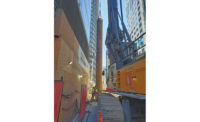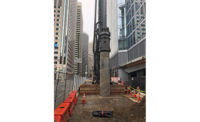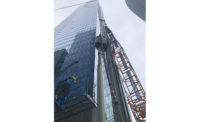On Oct. 13, Shimmick Construction Co. successfully completed the 36-in.-dia pilot pile-casing installation at San Francisco’s Millennium Tower, proving the efficacy of the initial step of a less-disruptive construction method proposed to allow the resumption of the paused foundation fix at the ailing 645-ft-tall residential condominium.
Accelerated settling and tilt—caused by the very perimeter pile upgrade intended to correct some 17 in. of building settlement—ceased after Aug. 20, when Ronald O. Hamburger, the engineer-of-record for the $100-million foundation upgrade, halted the work.
The casing was driven 106 ft below ground over two days beginning Oct.12, according to Patrick Hannan, communications director for the San Francisco Dept. of Building Inspection (DBI).
During the test, building settlement was 0.001 ft, the smallest amount readable with the survey methods used and “a fraction of what was encountered in previous installations,” says Hamburger, a senior principal with Simpson Gumpertz & Heger.
Measurements 80 ft below the ground surface indicated that vibration was "negligible," stated Hamburger, in his report to DBI. "It is unknown what the vibration amplitudes were in previous casing installations, but this indicates that vibration is no longer a significant factor in the 36-in. installations," Hamburger reported.
Benjamin Turner, a senior engineer with Dan Brown and Associates—a geotechnical and foundation engineer with expertise in drilling brought in to review Hamburger’s pilot pile proposal—was in attendance to observe and advise.
Hamburger was also at the jobsite. “The next step will be to test the improved procedures for installing 24-in.-dia piles to rock through the casings,” he says. If that test, which will use a smaller drill bit to minimize excavated material and vibrations, is similarly successful, “we look forward to completing the project without further delay,” he adds.
The 58-story tower, also known as 301 Mission Street, remains occupied. It has sunk a total of about 18 in. since its completion in 2008, due to the consolidation of Old Bay Clay, according to Hamburger. The fix itself, likened to putting a bumper jack next to a flat tire, accounts for about 1 in. of the total settlement.
Perimeter Pile Upgrade
The perimeter pile upgrade calls for 52 concrete-filled steel-pipe piles within steel casings, along two sides of the building. By Aug. 20, Shimmick’s Legacy Foundations had installed thirty-three 36-in.-dia pile casings and six 24-in.-dia steel-pipe piles. The contractor won’t comment on the fix, says Rusty Lucido, a Legacy vice president.
In an Oct. 7 letter to Patrick O’Riordan, interim director of the San Francisco DBI, Hamburger wrote: “We anticipate that installation of the [36-in.-dia] pilot casing will result in less than 1/8 in. of settlement at the building’s northeast corner with less than about 1/8 in. of additional tilting to the north and 1/4 in. to the west. As noted in the procedure document, we will stop the installation if settlement at the northeast corner exceeds 1/4 in., which would be accompanied by about 1/2 in. of tilting to the north and west. This is well within the building’s present tolerance for additional tilt.”
On Oct. 8, O’Riordan wrote to the Millennium Tower Association, which represents the condominium owners, explaining that DBI, the city’s engineering design review team (EDRT) and Dan Brown had reviewed Hamburger’s proposal and provided feedback.
DBI's support for the proposal to install one 36-in.-dia casing was based on certain conditions that O'Riordan called “representations and commitments” from the Millennium Tower Association, which is paying for the fix, and Hamburger’s team: Construction must cease immediately should settlement in the northeast corner exceed ¼ in. and Hamburger must immediately notify DBI, the EDRT and Dan Brown, which must have an engineer onsite during drilling of the pilot casing to observe, advise and provide guidance to minimize settlement.
During the pilot work, a DBI senior building inspector conducted a daily field inspection, primarily consulting with the special inspectors to confirm work was constructed to code.
Assessing Safety Impacts
The city expects Hamburger to use the data from the pilot casing installation to project the likely settlement through the upgrade’s completion and assess potential impacts on safety and building functionality. “In his proposal, Mr. Hamburger says he does not ‘anticipate impacts on safety’ and believes any functionality impacts can be addressed through ‘adjustments in piping and utilities,’” says the O’Riordan letter.
More information on Millennium Tower, including the monitoring reports of building settlement during the foundation fix, is available from DBI.
Currently, DBI, ERDT and Dan Brown are working with Hamburger and the Millennium Tower Association’s project team to understand the potential impact of additional pile and casing installations. Hamburger is not sure when the second part of the test, to install one 24-in.-dia pile, will occur. “We will push to do it soon,” he says.






Post a comment to this article
Report Abusive Comment